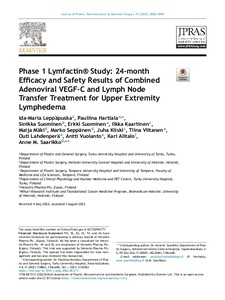Phase 1 Lymfactin® Study: 24-month Efficacy and Safety Results of Combined Adenoviral VEGF-C and Lymph Node Transfer Treatment for Upper Extremity Lymphedema
Leppäpuska Ida-Maria; Hartiala Pauliina; Suominen Sinikka; Suominen Erkki; Kaartinen Ilkka; Mäki Maija; Seppänen Marko; Kiiski Juha; Viitanen Tiina; Lahdenperä Outi; Vuolanto Antti; Alitalo Kari; Saarikko Anne M.
https://urn.fi/URN:NBN:fi-fe2022112968106
Tiivistelmä
BACKGROUND
Lymphedema is a common problem after breast cancer treatment. Lymfactin® is a prolymphangiogenic growth factor vector inducing the expression of human vascular endothelial growth factor C (VEGF-C). It promotes growth and repair of lymphatic vessels.
METHODS
Lymfactin® was combined with microvascular lymph node transfer surgery (VLNT) to study the safety and efficacy of the treatment in breast cancer-related upper limb lymphedema (BCRL) patients. This is a continuation study with a 3 year efficacy and 5 year safety follow-up.
RESULTS
Fifteen patients were recruited in the study between June 2016 and February 2018. Three patients received a lower dose (1 × 1010 viral particles (vp)), and 12 patients received a higher dose (1 × 1011 vp) of Lymfactin®, respectively. In the higher dose group, the reduction of excess arm volume was on average 46% after the 12 month follow-up, and the transport index was improved in 7/12 patients. At baseline, removal of the compression garment for 7 days resulted in significant arm swelling (105.7±161.0 ml, p=0.0253). However, at 12 months, there was less and not significant swelling after removal of the garment (84.4±143.0 ml, p=0.0682). Lymphedema Quality of Life Inventory (LQOLI or LyQLI) questionnaire showed significant and sustained improvement of quality of life.
CONCLUSIONS
During 24 months' of follow-up, the results indicate that Lymfactin® is well tolerated. The most promising findings were a 46% reduction in excess arm volume and a nonsignificant volume increase after garment removal at 12 months, suggesting that there is potential for the reduction of lymphedema.
Kokoelmat
- Rinnakkaistallenteet [27094]
